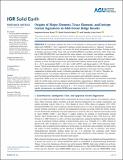| dc.contributor.author | Krein, Stephanie Brown | |
| dc.contributor.author | Behn, Mark Dietrich | |
| dc.contributor.author | Grove, Timothy L. | |
| dc.date.accessioned | 2021-10-01T14:25:32Z | |
| dc.date.available | 2021-10-01T14:25:32Z | |
| dc.date.issued | 2020-12 | |
| dc.date.submitted | 2020-02 | |
| dc.identifier.issn | 2169-9313 | |
| dc.identifier.issn | 2169-9356 | |
| dc.identifier.uri | https://hdl.handle.net/1721.1/132676 | |
| dc.description.abstract | To investigate whether the source of the globally occurring garnet signature in mid-ocean ridge basalt (MORB) is “true” (imparted by melting a garnet-bearing source) or “apparent” (produced without the involvement of garnet), we present the basalt petrogenesis model Petrogen. Petrogen is built on Kinzler and Grove (1992a, https://doi.org/10.1029/91JB02841) and Behn and Grove (2015, https://doi.org/10.1002/2015JB011885) and calculates the major element, trace element, and isotopic compositions of primary lherzolite-saturated mantle melts and their subsequent evolution to eruption. This model is experimentally calibrated for melting in the plagioclase, spinel, and garnet fields with and without small amounts of water. Petrogen predicts that garnet-lherzolite melting requires small mantle porosity (ϕ = ∼0.1%) and enriched (NaK# > 0.1), hot (>1400–1450°C), and damp mantle (>350–700 ppm water) sources. When garnet-lherzolite melting does occur, the fraction of melting that takes place in the garnet field is not sufficient to impart a recognizable true garnet signature in the major and trace element composition of pooled melts except at ultraslow-spreading rates (half rate ≤ 0.5 cm/yr). Therefore, for ambiguous garnet trace element signatures in MORB to be “true” would require that they are near-fractional garnet-lherzolite melts or garnet-pyroxenite melts diluted by mixing in random proportions. While we do not test the process of random mixing, we find that near-fractional and pooled melts of variable major and trace element mantle peridotite compositions at different mantle potential temperatures can explain the range of garnet signatures in MORB. For spinel-peridotite melting to support garnet signatures requires mantle porosities ϕ = ∼0.1%; however, plagioclase-peridotite melting, under specific circumstances, can explain MORB garnet signatures with ϕ = ∼1%. | en_US |
| dc.description.sponsorship | National Science Foundation (Grants OCE‐1458201, OCE‐1457916 and EAR‐1551321) | en_US |
| dc.language.iso | en | |
| dc.publisher | American Geophysical Union (AGU) | en_US |
| dc.relation.isversionof | http://dx.doi.org/10.1029/2020jb019612 | en_US |
| dc.rights | Article is made available in accordance with the publisher's policy and may be subject to US copyright law. Please refer to the publisher's site for terms of use. | en_US |
| dc.source | Prof. Grove | en_US |
| dc.title | Origins of Major Element, Trace Element, and Isotope Garnet Signatures in Mid‐Ocean Ridge Basalts | en_US |
| dc.type | Article | en_US |
| dc.identifier.citation | Krein, Stephanie Brown et al. "Origins of Major Element, Trace Element, and Isotope Garnet Signatures in Mid‐Ocean Ridge Basalts." Journal of Geophysical Research: Solid Earth 125, 12 (December 2020): e2020JB019612. ©2020. American Geophysical Union | en_US |
| dc.contributor.department | Massachusetts Institute of Technology. Department of Earth, Atmospheric, and Planetary Sciences | en_US |
| dc.relation.journal | Journal of Geophysical Research: Solid Earth | en_US |
| dc.eprint.version | Final published version | en_US |
| dc.type.uri | http://purl.org/eprint/type/JournalArticle | en_US |
| eprint.status | http://purl.org/eprint/status/PeerReviewed | en_US |
| dc.date.updated | 2021-09-30T15:07:57Z | |
| dspace.orderedauthors | Krein, SB; Behn, MD; Grove, TL | en_US |
| dspace.date.submission | 2021-09-30T15:08:01Z | |
| mit.journal.volume | 125 | en_US |
| mit.journal.issue | 12 | en_US |
| mit.license | PUBLISHER_POLICY | |
| mit.metadata.status | Complete | en_US |
